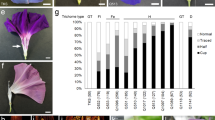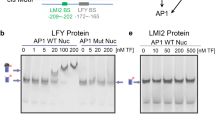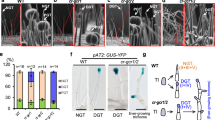Abstract
Trichomes are widespread in plants and develop from surface cells on different tissues1. They have many forms and functions, from defensive spines to physical barriers that trap layers of air to insulate against desiccation, but there is growing evidence that trichomes can also have developmental roles in regulating flower structure2,3. We report here that the trichomes on petals of cotton, Gossypium hirsutum L., are essential for correct flower bud shape through a mechanical entanglement of the trichomes on adjacent petals that anchor the edges to counter the opposing force generated by asymmetric expansion of overlapping petals. Silencing a master regulator of petal trichomes, GhMYB-MIXTA-Like10 (GhMYBML10), by RNA interference (RNAi) suppressed petal trichome growth and resulted in flower buds forming into abnormal corkscrew shapes that exposed developing anthers and stigmas to desiccation damage. Artificially gluing petal edges together could partially restore correct bud shape and fertility. Such petal ‘Velcro’ is present in other Malvaceae and perhaps more broadly in other plant families, although it is not ubiquitous. This mechanism for physical association between separate organs to regulate flower shape and function is different from the usual organ shape control4 exerted through cell-to-cell communication and differential cell expansion within floral tissues5,6.
This is a preview of subscription content, access via your institution
Access options
Subscribe to this journal
Receive 12 digital issues and online access to articles
$119.00 per year
only $9.92 per issue
Buy this article
- Purchase on Springer Link
- Instant access to full article PDF
Prices may be subject to local taxes which are calculated during checkout




Similar content being viewed by others
References
Evert, R. F. in Esau's plant Anatomy 3rd edn, 211–254 (Wiley, 2006).
Glover, B. J., Bunnewell, S. & Martin, C. Convergent evolution within the genus Solanum: the specialised anther cone develops through alternative pathways. Gene 331, 1–7 (2004).
El Ottra, J. H. L., Pirani, J. R. & Endress, P. K. Fusion within and between whorls of floral organs in Galipeinae (Rutaceae): structural features and evolutionary implications. Ann. Bot. 111, 821–837 (2013).
Johnson, K. & Lenhard, M. Genetic control of plant organ growth. New Phytol. 191, 319–333 (2011).
Mirabet, V., Das, P., Boudaoud, A. & Hamant, O. The role of mechanical forces in plant morphogenesis. Ann. Rev. Plant Biol. 62, 365–385 (2011).
Sampathkumar, A., Yan, A., Krupinski, P. & Meyerowitz, E. M. Physical forces regulate plant development and morphogenesis. Curr. Biol. 24, R475–R483 (2014).
Stracke, R., Werber, M. & Weisshaar, B. The R2R3-MYB gene family in Arabidopsis thaliana. Curr. Opin. Plant Biol. 4, 447–456 (2001).
Serna, L. & Martin, C. Trichomes: different regulatory networks lead to convergent structures. Trends Plant Sci. 11, 274–280 (2006).
Ramsay, N. A. & Glover, B. J. MYB–bHLH–WD40 protein complex and the evolution of cellular diversity. Trends Plant Sci. 10, 63–70 (2005).
Noda, K., Glover, B. J., Linstead, P. & Martin, C. Flower colour intensity depends on specialized cell shape controlled by a Myb-related transcription factor. Nature 369, 661–664 (1994).
Martin, C. et al. The mechanics of cell fate determination in petals. Phil. Trans. R. Soc. Lon. B Biol. Sci. 357, 809–813 (2002).
Machado, A., Wu, Y., Yang, Y., Llewellyn, D. J. & Dennis, E. S. The MYB transcription factor GhMYB25 regulates early fibre and trichome development. Plant J. 59, 52–62 (2009).
Walford, S. A., Wu, Y., Llewellyn, D. J. & Dennis, E. S. GhMYB25-like: a key factor in early cotton fibre development. Plant J. 65, 785–797 (2011).
Paterson, A. H. et al. Repeated polyploidization of Gossypium genomes and the evolution of spinnable cotton fibres. Nature 492, 423–427 (2012).
Bedon, F., Ziolkowski, L., Walford, S. A., Dennis, E. S. & Llewellyn, D. J. Members of the MYBMIXTA-like transcription factors may orchestrate the initiation of fibre development in cotton seeds. Front. Plant Sci. 5, 179 (2014).
Endress, P. K. Symmetry in flowers: diversity and evolution. Int. J. Plant Sci. 160, S3–S23 (1999).
Kohel, R. J. Genetic analysis of the open bud mutant in cotton. J. Hered. 64, 237–238 (1973).
Qian, N., Zhang, X.-W., Guo, W.-Z. & Zhang, T.-Z. Fine mapping of open-bud duplicate genes in homoelogous chromosomes of tetraploid cotton. Euphytica 165, 325–331 (2009).
Oshima, Y. et al. MIXTA-like transcription factors and WAX INDUCER1/SHINE1 coordinately regulate cuticle development in Arabidopsis and Torenia fournieri. Plant Cell 25, 1609–1624 (2013).
Walford, S. A., Wu, Y., Llewellyn, D. J. & Dennis, E. S. Epidermal cell differentiation in cotton mediated by the homeodomain leucine zipper gene, GhHD-1. Plant J. 71, 464–478 (2012).
Rao, S. S. R. Structure and distribution of plant trichomes in relation to taxonomy: Hibiscus L. Feddes Repertorium 102, 335–344 (1991).
Carvalho-SobrinhoI, J. G., Assis Ribeiro dos Santos, F. & Queiroz, L. P. Morphology of trichomes in petals of Pseudobombax Dugand (Malvaceae, Bombacoideae) species and its taxonomic significance. Acta Bot. Bras. 23, 929–934 (2009).
Adedeji, O., Ajuwon, O. Y. & Babawale, O. O. Foliar epidermal studies, organographic distribution and taxonomic importance of trichomes in the family Solanaceae. Int. J. Bot. 3, 276–282 (2007).
Weberling, F. Morphology of Flowers and Inflorescences 13–16 (Cambridge Univ. Press, 1992).
Douglas, A. W. The developmental basis of morphological diversification and synorganization in flowers of the Conospermeae (Stirlingia and Conosperminae: Proteaceae). Int. J. Plant Sci. 158, S13–S48 (1997).
Zhang, T. et al. Sequencing of allotetraploid cotton (Gossypium hirsutum L. acc. TM-1) provides a resource for fibre improvement. Nature Biotech. 33, 531–537 (2015).
Helliwell, C. A., Wesley, S. V., Wielopolska, A. J. & Waterhouse, P. M. High-throughput vectors for efficient gene silencing in plants. Funct. Plant Biol. 29, 1217–1225 (2002).
Talbot, M. & White, R. Methanol fixation of plant tissue for scanning electron microscopy improves preservation of tissue morphology and dimensions. Plant Meth. 9, 36 (2013).
MacMillan, C. P., Mansfield, S. D., Stachurski, Z. H., Evans, R. & Southerton, S. G. Fasciclin-like arabinogalactan proteins: specialization for stem biomechanics and cell wall architecture in Arabidopsis and Eucalyptus. Plant J. 62, 689–703 (2010).
Acknowledgements
We thank E. Johnston, H. Martin and J. Radik for technical assistance, Z. Stachurski (Australian National University) for assistance with biomechanical testing and M. Talbot for assistance with SEM. The authors acknowledge the Black Mountain Bioimaging Centre for instrumentation, training and technical support. This work was supported by funding from the Monsanto Company and Cotton Breeding Australia (a joint venture between CSIRO and Cotton Seed Distributors).
Author information
Authors and Affiliations
Contributions
D.L. and E.S.D. conceived the project. D.L. and S.-A.W. provided materials. J.T. performed the experiments. All authors analysed data and wrote and approved the manuscript.
Corresponding author
Ethics declarations
Competing interests
The authors declare no competing financial interests.
Supplementary information
Supplementary Information
Supplementary Figs 1-10. (PDF 3232 kb)
Supplementary Video 1
Real-time imaging of the tension meter testing of the forces required to separate adjoined petals. (MP4 1895 kb)
Rights and permissions
About this article
Cite this article
Tan, J., Walford, SA., Dennis, E. et al. Trichomes control flower bud shape by linking together young petals. Nature Plants 2, 16093 (2016). https://doi.org/10.1038/nplants.2016.93
Received:
Accepted:
Published:
DOI: https://doi.org/10.1038/nplants.2016.93
This article is cited by
-
The R2R3-MYB gene CgMYB4 is involved in the regulation of cell differentiation and fiber development in the stamens of Chelone glabra L.
Protoplasma (2022)
-
Evolution of ALOG gene family suggests various roles in establishing plant architecture of Torenia fournieri
BMC Plant Biology (2018)
-
Heterochronic developmental shifts underlie floral diversity within Jaltomata (Solanaceae)
EvoDevo (2017)
-
Development: A new function of plant trichomes
Nature Plants (2016)



